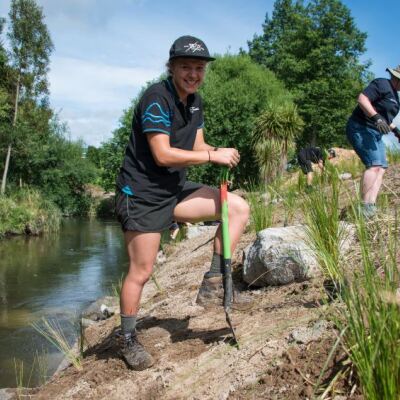
19 December 2018
High priority works to improve stream health and repair erosion damage are progressing on several streams in the Rotorua area.
Bay of Plenty Regional Council has been stabilising stream banks with rock armouring, re-establishing trout habitats and has planted more than 700 native plants to help regenerate the Ngongotaha Stream after a severe weather event caused significant erosion along its banks last April.
“We expect to complete repairs at five separate erosion sites on the Ngongotahā Stream before Christmas,” said Bay of Plenty Regional Council Area Engineer Kerry Smith.
Mr Smith said that his team has also just finished repairs on the Utuhina and Puarenga streambanks with the placement of 700 tonnes of rock armouring.
It is expected they would use 600 tonnes regenerate the Ngongotahā Stream too, he said.
Rock armouring will strengthen and stabilise the local stream banks which can be fragile due to the light pumice and soft soils that are present naturally. Grass and native plants will be added once the rock armouring sites have settled.
As apart of this work, Regional Council has been collaborating with Rotorua Lakes Council on stream erosion repairs. This includes identifying opportunities to repair significant erosion sites on stream banks that impact properties, reserves, walk and cycle ways.
Mr Smith said that other work underway by Regional Council includes gathering cross-section survey data on the Ngongotahā Stream which began in the last few weeks.
Outcomes of the survey, which is due to be completed in January, will inform future flood modelling work and the development of options for engineered flood control mitigation.
“The cross-sectional survey involves measuring stream capacity and recording width, depth and bank height at 70 sites along the stream. That information can be used to model the impacts of different sized rainfall events on the catchment and help identify any places that stream banks are vulnerable to overtopping under different scenarios.
“It will provide information that councils and communities can use to explore options for mitigating flood risk from the Ngongotahā Stream,” he said.
Mr Smith is asking locals who use the Ngongotahā Stream over summer to take care to avoid tripping on survey pegs and please leave any they find in place.
Rotorua Lakes Council Sports, Recreation and Environment Manager Rob Pitkethley said it had been really positive working with Regional Council to deliver a more coordinated and streamlined approach to stream bank damage besides waterways in the district.
“During this year our Open Spaces team has helped to identify issues like erosion and by working with the team at Regional Council we have had more of an opportunity to enhance our natural environment, improve the adjoining recreational spaces and connect with the neighbouring communities,” he said.
"Erosion control, tree removal and plant management or restorative planting is something that both Councils can work on together to proactively improve the outcomes for our community."Councils work together to regenerate local waterways.